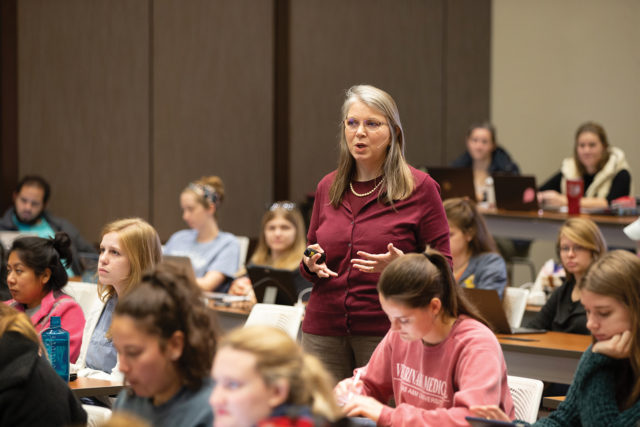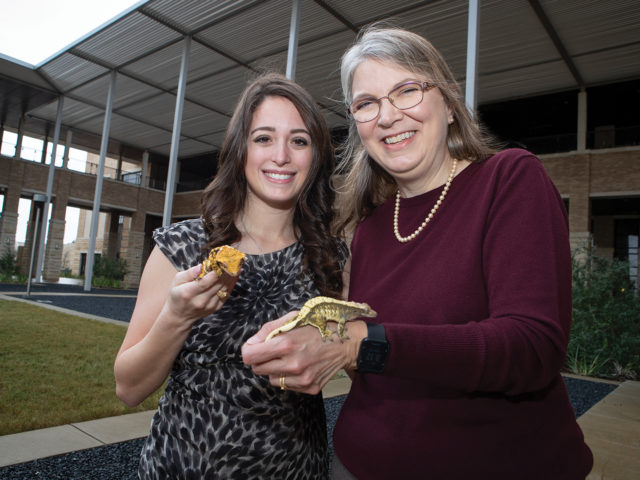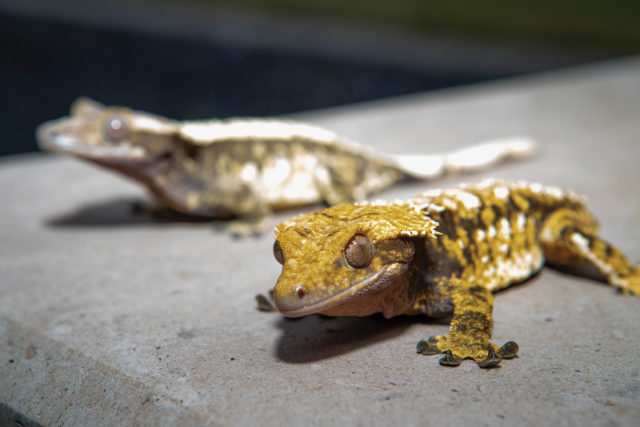Catching The Teaching Bug
Story by Emma Stogsdill
Although she never anticipated a career in the classroom, Dr. Sara Lawhon has found the best of both worlds by combining her passions for research and education.

French microbiologist Louis Pasteur once said, “Chance favors the prepared mind.”
Few embody this mantra as wholeheartedly as Dr. Sara Lawhon, an associate professor in the Texas A&M College of Veterinary Medicine & Biomedical Sciences’ (CVM) Department of Veterinary Pathobiology (VTPB).
Lawhon began her journey at Texas A&M in 1987 with the dream of becoming a small animal veterinarian. After completing a bachelor’s degree in biomedical sciences, she returned in 1993 in pursuit of her Doctor of Veterinary Medicine (DVM) degree.
But four years later, as she neared graduation from veterinary school, her focus began to shift. At the time, she was studying under pathologist Paul Frelier, who proposed that she stick around to fill an open postdoctoral position.
After graduation, she took him up on his offer; however, making the decision to go with the flow didn’t come easily.
“I had sworn I wasn’t going to do that,” she recalled, in reference to her post-doctoral work, “but spending time in Dr. Frelier’s lab inspired me. The work we were doing married clinical diagnostics and research in a way that sparked my interest in microbiology.
“It was exciting,” Lawhon remembers.
This marked the start of her transition from one goal to another; as she drifted from the idea of becoming a small animal veterinarian and toward her new passion, she began looking for microbiology residencies.
As Lawhon saw it, she had three options worth considering, and one of them was at North Carolina State. Once again, an opportunity had found her and she went with it—and was happy to do so somewhere with a favorable climate.
“I’m a Texas girl,” she said, adding that the warm weather had a major impact on her ultimate decision, “and fortunately for me, they were willing to take me on.”
While completing her residency in infectious diseases and her Ph.D. at the North Carolina State University College of Veterinary Medicine, she discovered her passion for Salmonella.
“I didn’t expect to spend my life or career thinking about Salmonella and carbon metabolism,” she recalled. “The science behind the Ph.D. was very basic, but we got to do a lot of things that really had application and direct clinical relevance. It was really a lot of fun.”

With the support of clinical microbiologist Dr. Craig Altier during her residency, and through application and direct clinical relevance, basic science came to life.
After this, Lawhon returned to Texas A&M as a postdoctoral researcher with Dr. L. Garry Adams and, in 2008, became an assistant professor. However, once again, this was not always part of her plan; she had loved A&M during her time here but never thought it would be her ultimate landing place.
“I was certainly supportive of (coming back) as an option,” she recalled. “(But) you just never know what’s going to happen and what jobs are going to be available. I was open to being other places, as long as there was good science, good people, and interesting diseases.”
So, with the support of her family and husband Ian, as well as her love for College Station, she returned to A&M, where she has been ever since.
She joined the CVM as associate director for the Veterinary Medical Teaching Hospital (VMTH), where on day two, her interest in Salmonella expanded to include the genome sequencing of Staphylococcus. Looking for virulence factors (molecules produced by bacteria that help the bacteria cause disease in a host), antibiotic resistance genes, and investigating case studies of natural infections all became part of her growing list of responsibilities.
These are still her primary interests, but now, Lawhon does three main things; in addition to teaching, she is a clinical microbiologist for the VMTH and the director of the clinical microbiology and clinical immunology laboratory.
Likening herself to “Happy Gilmore,” who thought of himself as more of a hockey player than a golfer, Lawhon sees herself as “a researcher who gets to teach.”
But it’s a role in which she excels, so much so that in 2018, she was recognized by the Association of American Veterinary Medical Colleges (AAVMC) with the Distinguished Veterinary Teacher Award, presented by Zoetis.
Important for Lawhon is that her teaching and research are often combined.
She emphasized the value of protecting antibiotic resources, adding that part of her goal is to ensure that her students still have many antibiotics to use when they are in their 20th or 30th year of practice.
“We all want for the next generation to still have the tools and resources that antibiotics provide,” she said. “We translate whatever struggles we have in finding information for a patient into an easier way for somebody in the future to find a diagnosis and a good therapeutic agent faster.”
In addition to the Distinguished Veterinary Teacher Award, this spring, Lawhon also received the Students of the American Veterinary Medical Association’s (SAVMA) 2019-2020 Teaching Excellence Award, an international honor that recognizes outstanding teachers in the profession.
Fourth-year veterinary student Rachel Ellerd, who nominated Lawhon for the award, says she is both an excellent teacher and mentor who encourages students to follow their passions.
During a class activity on fecal floats, Ellerd discovered that very little peer-reviewed research existed on crested geckos. Under Lawhon’s guidance, Ellerd began a project on a variety of lizards that is set to become a published paper.

“Dr. Lawhon is undoubtedly very busy during the semester; however, there was no hesitation when she agreed to take time out of her weekend to help me analyze gecko fecal samples,” Ellerd said. “Although she specializes in Salmonella and had nothing to gain by helping with my project, she spent hours assisting with data collection, research, and development, just to foster a love of research in one of her students.”
This type of forward-thinking teaching has inspired countless students, who said while Lawhon expressed surprise in winning the teaching awards, they would have been surprised if she hadn’t been awarded it.
One of her two current Ph.D. students, Sara Little, said Lawhon has been a huge source of support.
“I feel like with her guidance, and her advice, and her support, it’s been more of an all-around growth instead of just your Ph.D. in science,” Little said, with those milling around the room nodding in agreement. “She’s been an example of how to live my life, how to ‘adult,’ and how to be a caring person.”
In addition, Lawhon’s care for her students extends beyond the classroom and lab; Little says Lawhon even invites students to her home for holidays.
“We don’t necessarily get the chance to go back to our families,” Little smiled. “So, every year, she always hosts a Thanksgiving dinner and a Christmas party, giving all of us little grad student ’orphans’ somewhere to go.”
“I have great students,” Lawhon said. “You don’t just wake up one morning and say, ‘I want to be a veterinarian.’ You might initially have done that, but then you’re going to put in another dozen years of hard work to get to that point. And then when you get to that point, you’re going to work even harder, so they work really hard to be the best possible veterinarians that they can be.”
When discussing her reception of the awards, Lawhon emphasized how humbling it is to know that her students elected her for the awards.
“That’s incredibly personally satisfying, to get to be a little piece in their story, in their timeline,” she said. “It is really positive and rewarding to share what I get to see at the bench with people that I hope that will find it useful.”
Ultimately, Lawhon never guessed that she would be where she is today, but she is glad that her journey has brought her back to A&M. Here, she has the opportunity to inspire future microbiologists, all while making her own positive changes in the world.
“You do your best with your education and be prepared when opportunities arise,” she said. “I try to create those same kinds of opportunities for my students now because you just might find your Salmonella somewhere out there. So, if you have the opportunity to try a bunch of different things, it can take you interesting places.”
###
Note: This story originally appeared in the Spring 2020 edition of CVM Today.
For more information about the Texas A&M College of Veterinary Medicine & Biomedical Sciences, please visit our website at vetmed.tamu.edu or join us on Facebook, Instagram, and Twitter.
Contact Information: Jennifer Gauntt, Director of Communications, Texas A&M College of Veterinary Medicine & Biomedical Sciences; jgauntt@cvm.tamu.edu; 979-862-4216


